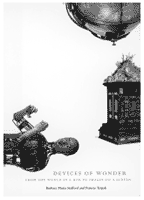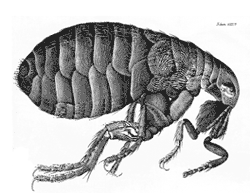![]()
In our Opinion
Optics and Reality
 By: Robert Hirsch and Greg Erf From Vol. 2 No. 5 |
1 |
|
Recently there has been much hoopla about how the fundamental optical concepts of photography have influenced the way artists represent the world. The controversy has centered on David Hockney’s Secret Knowledge: Rediscovering the Lost Techniques of the Old Masters (Viking Studio) and an exhibition of Thomas Eakins work at the Philadelphia Museum of Art (the catalogue edited by Darrel Sewell is available from Yale University Press, ISBN 0-300-09111-7).
Using paintings as his physical evidence, Hockney makes an intriguing visual case that artists were relying on concave mirrors and optics as early as 1420 to formulate their pictures, even though scholars have punched big holes in his theory. In Eakins case the team putting together the exhibition uncovered hard physical evidence that shows how Eakins directly used photographs to make some of his paintings during the late 1800s.
Why is this big news? It goes back to issues surrounding the value of painting based on the premise that painters represent an almost divine, direct, and uninterrupted linkage to the creative eye and hand of the artist. These findings disturb cherished myths of painters as geniuses and photographers as handmaidens of art because photography is a mechanical vision. People do not realize how our system for representing the world has evolved in response to elemental changes in our culture and how knowledge is passed on. As better mousetraps are invented artists have been quick to adopt those that make their job easier and faster. Just as the printing press made information more accessible, improvements in mirrors and the introduction of optics gave artists innovative and more flexible aesthetic ways to represent life to a growing audience.
What we call photography did not magically appear one day. Its roots can be traced back to the writings of the ancient Greeks. What developed was a system of observation reliant on visual and chemical inventions that were brought together into the concept of photography. The photographic image is rooted in Renaissance single-point perspective, which is the result of centuries of evolution reflecting a societal compact about developing a common visual language. From this lineage of optical devices came the invention of the camera obscura and camera lucida, the latter so frustrated William Henry Fox Talbot that he invented the negative/ positive system of photography (for more on this fascinating subject see the superbly done Devices of Wonder: From the World in a Box to Images on a Screen by Barbara Maria Stafford and Frances Terpak.
| Eakins, who was hailed as the greatest draftsman of the nineteenth century, concealed that he traced from photographs, even though he could draw with exceptional skill. The point is not that Caravaggio, Jan van Eyck, or Eakins “cheated,” but that they employed the most up-to-date means of representing time and space that redefined notions of artistic realism and truth. In The Painter and the Photograph: From Delacroix to Warhol, 1972 (out of print) Van Deren Coke provides numerous visual links between photography and other mediums. Although this may disappoint some clinging to romantic notions about what an artist should be, it demonstrates the influence of photography and how artists recognized and incorporated these attributes into their work. This fuss also points out the general lack of knowledge, even by experts, about how artists really work. Artists, not brushes or optics, make pictures. This debate reveals that optics are just another tool and how well an artist uses that tool will determine the quality of the outcome. The mechanical and scientific way a camera forms an outward image of a subject gives the impression it is close to the truth. Eakins and Hockney used this belief by filtering it through their own creative processes to add another dimension of realism to their work. |
 The use of a magnifying glass shows the rational drive to utilize optics tolearn more about the world through observation and the realistic recording of detail, which help lay the foundation for the invention of photography. Observations of a Flea, 1665. Engraving. 14 - 1/2x18 inches. From Robert Hooke, Micrographia; or, some Physiological Descriptions of Minute bodies Made by Magnifying Glasses (London: J. Martyn & J. Allestry [for] Royal Society, 1665), pl. 34. |
Shifts to the creative process brought on by technology require time for reflection so artists can comprehend what it has to offer in regards to the expansion of the language of vision. History shows how skilled artists used optical devices to plot precise details in specific locations on a flat plane and how the perfecting of chemical processes let artists permanently capture reality for future transferal to other surfaces.
Ironically, digital imaging has ruptured the legend of photographic veracity and this may allow photographers to expand photography’s role and lexicon in the same manner that photography freed painters to advance beyond realism and invent cubism, surrealism, and abstraction.
This current uproar circles back to the question of how we represent reality and just how crucial is the direct use of the hand in presenting these findings? Aside from the need to do a better job of explaining how the artistic process functions to the public and debunking fallacies, the key question is how does this affect a working artist?
Photographers are caught between making images rooted in optical reality that fascinates people with its ability to show every hair on a flea, and how the use of optics has been condemned for removing a potent ingredient of creative intelligence attributed to other media. What people fail to acknowledge is the linkage between the mind and the hand regardless of whether the tool being used is a camera, a computer, or a paintbrush. Our judgments should be determined on what artists are able to achieve with their tools and not what tools they use. What matters, regardless of whether the optics are the eyeball, a camera lucida or a view camera, is an artist’s ability to use their creative process to visually interpret and connect emotions, facts, and fantasies.
Eakins possessed these abilities and his use of photography mirrored his aesthetic concerns and talents. For Eakins photography not only provided a more efficient way of working, but it also extended the accuracy and knowledge of his vision as in the case of how he painted the movement of horses (Eakins briefly worked with Eadweard Muybridge). Eakins did not reveal his use of photography because it was considered unacceptable in terms of the expectations surrounding artistic process.
Working under an unreasonable expectation is a terrible handicap. In the recent Salt Lake City Winter Olympics improvements in physical training and new technologies produced record-breaking performances that were unimaginable 20 years ago. People expect and accept athletes to improve their performance so why do they object when artists do the same?
Artists need freedom to seek new ways of conducting challenging aesthetic experiments that allow them to wonder and display their discoveries. Socrates said wonder is the recognition of ignorance. Wonder is an aesthetic state that allows us to acknowledge what we do not know. Wonder also pulls and pushes at our definitions of visual truth and reality.
Regardless if artists use optics or pencils, they must examine their aesthetic state of mind to realize new aesthetic experiences. The attention being given to the evolution of optical principles acknowledges photography’s unique artistic and scientific structure, whether it is used to look at a face, a flea, or the moon, and its influence on how we know our world.

